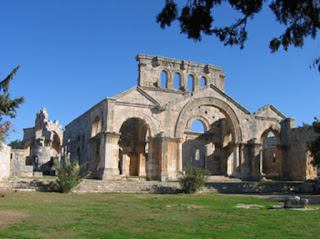 |
| The remains of Palmyra news.nationalgeographic.com |
Before we begin, yours truly would like to acknowledge the fact that we have reached 80,000 page views. This is quite an accomplishment in over 3-1/2 years. Yours truly is genuinely touched by your continued readership. Thank you.
Today we are going talk about cultural heritage. Specifically, we are going to discuss what happens when a cultural heritage site gets caught in the cross hairs of military action. Andrew E. Kramer and Sewell Chan's recent article for the New York Times, "When Cultural Heritage is Caught in the Cross Hairs," looks at examples sites of cultural heritage affected by combat. Palmyra and other sites around Syria have a history of being trapped in the middle of combat. There are other sites, around the world, that have been affected by military action
 |
| Proposed Palmyra reconstruction architectural record.com |
The site presently is well fortified. However, according to the Cultural Initiative of the American Schools of Oriental Research has warned that the continued Russian presence is in close proximity to the site and could endangered the remaining treasure. In an aside Messrs. Kramer and Chan write, "The Associated Press quoted Russian officials as saying that the base was only temporary, to house experts removing explosives.
 |
| Church of St. Simeon Stylites Aleppo, Syria sacred-destination.com |
Other sites around Syria continue to suffer damage. One example is the Church of St. Simeon Stylites. The monastery in northwest Aleppo, dedicated to the fifth century monk who spent decades in solitary contemplation, was damage by missiles. The authors report, "The Syrian Army used a medieval cited overlooking ancient Palmyra as a military base, and numerous Syrian sites-including the Great Mosque of Aleppo and the Crac des Chavaliers...have been damaged during the five-year civil war..."
The 1954 Convention for the Protection of Cultural Property in the Event of Armed Conflict with Regulation for the Execution of the Convention (portal.unesco.org) requires nations to refrain from destroying "cultural property" during conflict but that has not stopped the destruction. Sites in Palmyra and Aleppo are not the only places of destruction of cultural heritage sites.
 |
| The Parthenon Athens, Greece en.wikipedia.org |
During the 17th-century, the Ottoman Empire, authorities used this fifth century B.C.E. temple to store ammunition, shelter women and children from Venetian forces. The Venetians fired on the temple and about 700 cannonballs hit the western elevation. The gunpowder inside the building ignited, blowing up 28 columns, wrecking interior rooms, and killing up to 300 people.
In the early 19th-century, British diplomat Lord Elgin paid the Ottoman authorities for the cache of sculptures and reliefs, moving the treasure to Great Britain, where they are on exhibit in the British Museum. The Greek government has fought unsuccessfully for decades to re-patriot the Parthenon treasures.
 |
| Old Summer Palace (recreation) Beijing, China oktrips.com |
In October 1860, Lord Elgin, son of the Lord Elgin who carted off the Parthenon reliefs, ordered the destruction of the Old Summer Palace, the 18th-century architectural gem build outside the Forbidden City. It was at the close of the Second Opium War, which Britain and France allied themselves against the Qing Dynasty army. Lord Elgin fils ordered the destruction of the palace in retaliation for the imprisonment and torture of British and French negotiators. The massive scale of the destruction has become an enduring symbol of national humiliation. There have been occasional calls for the palace to be rebuilt.
 |
| Leuven, Belgium late 19th-century en.wikipedia.org |
Leuven, Belgium
In August 1914, close to the start of World War I, German military forces set fire to the university library in Leuven. The fire killed over 200 residents and forced thousands of others to flee the city as part of what Allied propaganda called "the Rape of Belgium." The writers own newspaper, the New York Times, called this act an unforgivable injury to the entire world. Approximately 200,000 works, included irreplaceable medieval and Renaissance volumes were incinerated.
 |
| Montecassino Abbey Monte Cassino, Italy sacred-destination.com |
This mountaintop Benedictine monastery was built in the sixth century and destroyed by Allied bombers in February 1944. The Allies mistakenly bombed the Abbey, believing that German troops were inside. However, the over 200 Italian civilians that took refuge in the monastery were killed. In a side note, Messrs Kramer and Chan write, "German paratroopers did later occupy the ruins and used the bombed-out abbey as an observation post." One account describes the bombing as a the result of translation error. Winston Churchill defended the abbey's destruction, writing,
The monastery did not contain German troops, but the enemy fortifications were hard separate from the building itself.
 |
| Hue, Vietnam villalouisehue.com |
Hue was established as the capital of unified Vietnam in 1802. It was the political, cultural religious center of Nguyen dynasty, which reigned untiled the end of World War II. Most of its great edifices were destroyed by the Vietcong in the beginning of 1968, during the Tet Offensive. This prompted a ferocious counterattack by the South Vietnamese Army, supported by the United States. The ensuing siege ended with the Vietcong being ousted from the ancient citadel. Further nearly half of Hue's homes were destroyed and thousands of people were killed.
What these examples teach us is that sites of cultural heritage are not immune to destruction from military conflict. They are valuable documents of a time and people in history. They are reminders of how people lived and worshipped. When they are destroyed, they are erased from history. Computer models and 3-D printers can help use visualize what they looked like but not the experience of place. Cultural heritage sites are part of our history and must be protected.
No comments:
Post a Comment